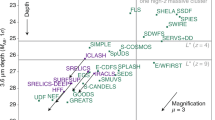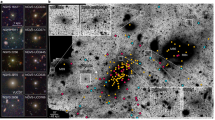Abstract
An analysis of 150 QSO red-shifts suggests that there are groupings of QSOs extending over large areas of sky. The inference is that QSOs are not at cosmological distances.
This is a preview of subscription content, access via your institution
Access options
Subscribe to this journal
Receive 51 print issues and online access
$199.00 per year
only $3.90 per issue
Buy this article
- Purchase on Springer Link
- Instant access to full article PDF
Prices may be subject to local taxes which are calculated during checkout
Similar content being viewed by others
References
Burbidge, G. R., and Burbidge, E. M., Nature, 222, 735 (1969).
Burbidge, G., Astrophys. J. Lett., 154, L41 (1968).
Roeder, R. C., and Verreault, R. T., Astrophys. J., 155, 1047 (1969).
Author information
Authors and Affiliations
Rights and permissions
About this article
Cite this article
BELL, M. Clusters of Quasi-stellar Objects. Nature 224, 229–234 (1969). https://doi.org/10.1038/224229a0
Received:
Issue Date:
DOI: https://doi.org/10.1038/224229a0
This article is cited by
-
The significance of spatial curvature for energy output of remote quasars
Astrophysics and Space Science (1987)
-
Some trends in the red-shift distribution of quasi-stellar objects and related peculiar galaxies
Astrophysics and Space Science (1972)
-
Angular Distribution of Quasistellar Objects
Nature Physical Science (1971)
-
Supergalaxy and the quasi-stellar sources
Astrophysics and Space Science (1971)
Comments
By submitting a comment you agree to abide by our Terms and Community Guidelines. If you find something abusive or that does not comply with our terms or guidelines please flag it as inappropriate.



